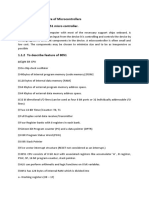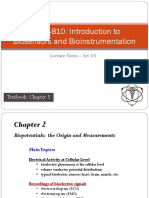0 ratings0% found this document useful (0 votes)
160 viewsPin Diagram 8051
Pin Diagram 8051
Uploaded by
Kritika KritikaThe document describes the pins of an 8051 microcontroller. It discusses the functions of Port1 (Pins 1-8), Pin 9 (reset), Port3 (Pins 10-17), Pins 18-19 (oscillator), Port2 (Pins 21-28), Pins 29-31 (external memory interface), Port0 (Pins 32-39), and Pin 40 (power supply). Key pins include those for ports, reset, oscillator, external memory interface, and power.
Copyright:
© All Rights Reserved
Available Formats
Download as PPTX, PDF, TXT or read online from Scribd
Pin Diagram 8051
Pin Diagram 8051
Uploaded by
Kritika Kritika0 ratings0% found this document useful (0 votes)
160 views7 pagesThe document describes the pins of an 8051 microcontroller. It discusses the functions of Port1 (Pins 1-8), Pin 9 (reset), Port3 (Pins 10-17), Pins 18-19 (oscillator), Port2 (Pins 21-28), Pins 29-31 (external memory interface), Port0 (Pins 32-39), and Pin 40 (power supply). Key pins include those for ports, reset, oscillator, external memory interface, and power.
Original Description:
Full description of Pin diagram of 8051 Microcontrollers
Copyright
© © All Rights Reserved
Available Formats
PPTX, PDF, TXT or read online from Scribd
Share this document
Did you find this document useful?
Is this content inappropriate?
The document describes the pins of an 8051 microcontroller. It discusses the functions of Port1 (Pins 1-8), Pin 9 (reset), Port3 (Pins 10-17), Pins 18-19 (oscillator), Port2 (Pins 21-28), Pins 29-31 (external memory interface), Port0 (Pins 32-39), and Pin 40 (power supply). Key pins include those for ports, reset, oscillator, external memory interface, and power.
Copyright:
© All Rights Reserved
Available Formats
Download as PPTX, PDF, TXT or read online from Scribd
Download as pptx, pdf, or txt
0 ratings0% found this document useful (0 votes)
160 views7 pagesPin Diagram 8051
Pin Diagram 8051
Uploaded by
Kritika KritikaThe document describes the pins of an 8051 microcontroller. It discusses the functions of Port1 (Pins 1-8), Pin 9 (reset), Port3 (Pins 10-17), Pins 18-19 (oscillator), Port2 (Pins 21-28), Pins 29-31 (external memory interface), Port0 (Pins 32-39), and Pin 40 (power supply). Key pins include those for ports, reset, oscillator, external memory interface, and power.
Copyright:
© All Rights Reserved
Available Formats
Download as PPTX, PDF, TXT or read online from Scribd
Download as pptx, pdf, or txt
You are on page 1of 7
Pin Description
Port1 (Pin1 to Pin8): Port1 includes pin1.0
to pin1.7 and these pins can be configured as
input or output pins.
Pin 9 (RST): Reset pin is used to Reset 8051
Microcontroller by giving a positive pulse to
this Pin.
Pin Description
Port3 (Pin 10 to 17): The Port3 Pins are similar to port1
pins and can be used as universal Input or output pins.
These pins dual-function Pins and the function of each Pin is
given as:
Pin 10 (RXD): RXD pin is a Serial Asynchronous
Communication Input or Serial synchronous
Communication Output.
Pin 11 (TXD): Serial Asynchronous Communication Output
or Serial Synchronous Communication clock Output.
Pin 12 (INT0): Input of Interrupt 0
Pin 13 (INT1): Input of Interrupt 1
Pin 14 (T0): Input of Counter 0 clock
Pin 15 (T1): Input of Counter 1 clock
Pin 16 (WR): Writing Signal to write content on external
RAM.
Pin 17 (RD): Reading Signal to read contents of external
RAM.
Pin Description
Pin 18 and 19 (XTAL2, XTAL1): X2 and X1
pins are input output pins for the oscillator.
These pins are used to connect an internal
oscillator to the microcontroller.
Pin 20 (GND): Pin 20 is a ground pin.
Pin Description
Port2 (Pin 21 to Pin28): Port2 includes
pin21 to pin28 which can be configured as
Input Output Pins. But, this is only possible
when we don’t use any external memory. If we
use external memory, then these pins will work
as high order address bus (A8 to A15).
Pin Description
Pin 29 (PSEN): This pin is used to enable
external program memory. If we use an external
ROM for storing the program, then logic 0 appears
on it, which indicates Micro controller to read data
from the memory.
Pin 30 (ALE): Address Latch Enable pin is an
active high-output signal. If we use multiple
memory chips, then this pin is used to distinguish
between them. This Pin also gives program pulse
input during programming of EPROM.
Pin 31 (EA): If we have to use multiple
memories then the application of logic 1 to this pin
instructs the Microcontroller to read data from
both memories: first internal and then external.
Pin Description
Port 0 (Pin 32 to 39): Similar to the port 2
and 3 pins, these pins can be used as input
output pins when we don’t use any external
memory. When ALE or Pin 30 is at 1, then this
port is used as data bus: when the ALE pin is at
0, then this port is used as a lower order
address bus (A0 to A7)
Pin40 (VCC): This VCC pin is used for power
supply.
You might also like
- DR Id1200 - 018 230 07e PDFDocument1,104 pagesDR Id1200 - 018 230 07e PDFSalvador Cajas100% (1)
- Power ElectronicsDocument42 pagesPower Electronicsevonik123456No ratings yet
- Probabilistic Power AnalysisDocument48 pagesProbabilistic Power AnalysissridharNo ratings yet
- FPA 5000 Installation Manual enUS 1218442507 PDFDocument170 pagesFPA 5000 Installation Manual enUS 1218442507 PDFYassine AhmedNo ratings yet
- G 30 RCDDocument3 pagesG 30 RCDstreetsweeper98No ratings yet
- Lecture 1 Pin Descriptin of 8051Document3 pagesLecture 1 Pin Descriptin of 805112343567890No ratings yet
- 8051 Microcontroller Pin DiagramDocument2 pages8051 Microcontroller Pin DiagramsabirNo ratings yet
- MicrocontrollerDocument2 pagesMicrocontrollerPrashanthi ReddyNo ratings yet
- Distance Measurement SystemDocument31 pagesDistance Measurement Systemnikhitha100% (1)
- 4363741911Document26 pages4363741911Arnav Singh100% (1)
- 8051 Pin Diagram & It'S Each Function: 8051 Pin Diagram & It'S Each Function: 8051 Pin Diagram & It'S Each FunctionDocument22 pages8051 Pin Diagram & It'S Each Function: 8051 Pin Diagram & It'S Each Function: 8051 Pin Diagram & It'S Each FunctionShiuli BarmanNo ratings yet
- Pin Diagram 8051 RevisedDocument2 pagesPin Diagram 8051 Revisedcabdullaahi sheekh yaxyeNo ratings yet
- 2.1 What Is 8051 Standard?Document7 pages2.1 What Is 8051 Standard?Leena GhiwdondeNo ratings yet
- Unit 3Document10 pagesUnit 3Prasad ghumareNo ratings yet
- 2.2 Pinout DescriptionDocument27 pages2.2 Pinout DescriptionDeepak DineshNo ratings yet
- MPMC-Unit-2 NOTESDocument43 pagesMPMC-Unit-2 NOTESBhure VedikaNo ratings yet
- 8051 StandardDocument40 pages8051 StandardHARISH KONDURUNo ratings yet
- 2020 - Mca Solved PaperDocument5 pages2020 - Mca Solved Paperaniketkumarverma475No ratings yet
- Chapter 2: 8051 Microcontroller Architecture: 2.1 What Is 8051 Standard?Document46 pagesChapter 2: 8051 Microcontroller Architecture: 2.1 What Is 8051 Standard?వంశీ క్రిష్ణNo ratings yet
- 8051 Microcontroller PDFDocument31 pages8051 Microcontroller PDFHarshitha bottaNo ratings yet
- DevasheeshDocument17 pagesDevasheeshDevasheesh ManglaNo ratings yet
- Unit 3 - 8051 Programming in CDocument22 pagesUnit 3 - 8051 Programming in CSenthil KumarNo ratings yet
- Microcontrollers LAB Manual: LAB CODE: EC - 607, EE - 410Document28 pagesMicrocontrollers LAB Manual: LAB CODE: EC - 607, EE - 410Ajay PatilNo ratings yet
- Silicon Rectifier Diodes AC Adapters DO-41: Voltage 1 A Part 3 A PartDocument8 pagesSilicon Rectifier Diodes AC Adapters DO-41: Voltage 1 A Part 3 A PartMalagala CharanNo ratings yet
- Microcontroller 1 J2 and 3 Module NotesDocument38 pagesMicrocontroller 1 J2 and 3 Module NotesArun RajNo ratings yet
- B Sc. III Electronics SEM V Unit IIDocument40 pagesB Sc. III Electronics SEM V Unit IIAjuth Neema K BNo ratings yet
- Microcontroller Record 8051Document50 pagesMicrocontroller Record 8051netgalaxy2010No ratings yet
- Embedded Systems - 8051 MicrocontrollerDocument33 pagesEmbedded Systems - 8051 MicrocontrollerAarti DhotreNo ratings yet
- Lab ManualDocument7 pagesLab ManualraviNo ratings yet
- MCI Unit IVDocument46 pagesMCI Unit IVKonga MadhukarNo ratings yet
- 2.1 What Is 8051 Standard?Document27 pages2.1 What Is 8051 Standard?Geo BabuNo ratings yet
- 8051 Pin DiagramDocument20 pages8051 Pin DiagramVineet Kumar PandeyNo ratings yet
- 8051 Pin Configaration and ArchitectureDocument59 pages8051 Pin Configaration and Architecturesumaiya13255No ratings yet
- Seminar PresentationDocument24 pagesSeminar Presentationankyt807No ratings yet
- 8051 MicrocontrollerDocument60 pages8051 Microcontrollergokul docNo ratings yet
- 8051 Architecture Contains The Following:: Block DiagramDocument17 pages8051 Architecture Contains The Following:: Block DiagramAtul GoyalNo ratings yet
- I-O PortsDocument20 pagesI-O PortsPradeep V DevNo ratings yet
- 8051 MC BT-1-LAPTOP-LJ7D0M7SDocument23 pages8051 MC BT-1-LAPTOP-LJ7D0M7SDharmireddy PushpajaNo ratings yet
- Microcontroller 8051Document27 pagesMicrocontroller 8051Amandeep SinghNo ratings yet
- CS3691 - ES & IOT LabDocument38 pagesCS3691 - ES & IOT LabS.S.Rakesh MuthuNo ratings yet
- Microcontrollers: Created By: Sachin Bhalavat (Elect. & Comm. Engg.)Document52 pagesMicrocontrollers: Created By: Sachin Bhalavat (Elect. & Comm. Engg.)madhu518No ratings yet
- Pin Diagram of 8085Document48 pagesPin Diagram of 8085api-247714257No ratings yet
- 8051 MicrocontrollerDocument31 pages8051 Microcontrollernasof62012No ratings yet
- Unit 5 - Microprocessor & Its Application - WWW - Rgpvnotes.inDocument13 pagesUnit 5 - Microprocessor & Its Application - WWW - Rgpvnotes.inJayesh JoshiNo ratings yet
- Ntroduction To ARM7 LPC2148 MicrocontrollerDocument5 pagesNtroduction To ARM7 LPC2148 MicrocontrollercaseguysNo ratings yet
- Unit-2Document14 pagesUnit-2Guduri Anjaneya Vijaya Narasimha RajuNo ratings yet
- Unit - Iv Syllabus 8051 MicrocontrollerDocument52 pagesUnit - Iv Syllabus 8051 MicrocontrollerSakthivel Palani100% (1)
- Primer Tutorial On 8051Document21 pagesPrimer Tutorial On 8051ChanderKishoreJoshiNo ratings yet
- Notes Unit 1Document8 pagesNotes Unit 1Dr. Rajalakshmi MNo ratings yet
- Microcontroller 8051 - IntroductionDocument25 pagesMicrocontroller 8051 - IntroductionE.VigneshNo ratings yet
- Microprocessor Lab Manual EE0310Document44 pagesMicroprocessor Lab Manual EE0310sathishkumar.vNo ratings yet
- Project ReportDocument20 pagesProject ReportPiyush GuptaNo ratings yet
- Digital Thermometer Final ReportDocument22 pagesDigital Thermometer Final Reportrayedkhan100% (2)
- Mo MC 3 ChapDocument21 pagesMo MC 3 ChapHarsha MkrNo ratings yet
- AVR TutorialDocument5 pagesAVR TutorialAkhil PtNo ratings yet
- 8051 Notes 5 - Pin configuration & input output portsDocument3 pages8051 Notes 5 - Pin configuration & input output portsAnkit DeyNo ratings yet
- 3.3 Microcontroller:: Fig: 3.2: MicrocontrollersDocument20 pages3.3 Microcontroller:: Fig: 3.2: Microcontrollersnafisa sultanaNo ratings yet
- Notes Unit 1Document47 pagesNotes Unit 1Elakkiya N.SNo ratings yet
- 8051architecturesb 121025020524 Phpapp01Document50 pages8051architecturesb 121025020524 Phpapp01madhu518No ratings yet
- 8051 Microcontroller Objectives: Understand The 8051 Architecture Use SFR in C Use I/O Ports in CDocument59 pages8051 Microcontroller Objectives: Understand The 8051 Architecture Use SFR in C Use I/O Ports in CJeevan Reddy MandaliNo ratings yet
- How To Start Programming For ARM7 Based LPC2148 MicrocontrollerDocument5 pagesHow To Start Programming For ARM7 Based LPC2148 Microcontrollerrudra_1No ratings yet
- Intel 8051 MicrocontrollerDocument2 pagesIntel 8051 Microcontrollersifunatimothy509No ratings yet
- Control Unit - 89C52: Introduction About Micro ControllerDocument20 pagesControl Unit - 89C52: Introduction About Micro ControllerSubhashini AruchamyNo ratings yet
- Embedded MicrocontrollerDocument30 pagesEmbedded MicrocontrollervinoliabenitaNo ratings yet
- Preliminary Specifications: Programmed Data Processor Model Three (PDP-3) October, 1960From EverandPreliminary Specifications: Programmed Data Processor Model Three (PDP-3) October, 1960No ratings yet
- 1.the Two Basic Types of Transmission Line AreDocument4 pages1.the Two Basic Types of Transmission Line AreMcgravyNo ratings yet
- Revision of Chapter 08-LHB Power Car of LHB Manual (Electrical)Document58 pagesRevision of Chapter 08-LHB Power Car of LHB Manual (Electrical)Harsh Vardhan Singh100% (2)
- Understanding The Dynamic Mho Distance Characteristic: Donald D. Fentie, Schweitzer Engineering Laboratories, IncDocument15 pagesUnderstanding The Dynamic Mho Distance Characteristic: Donald D. Fentie, Schweitzer Engineering Laboratories, IncAdriano de CarvalhoNo ratings yet
- Motor Starter Selection Guide Average Full - Load Current of 3 - Phase Squirrel Cage MotorsDocument13 pagesMotor Starter Selection Guide Average Full - Load Current of 3 - Phase Squirrel Cage MotorsOm PrakashNo ratings yet
- Ai Anatomy MapDocument1 pageAi Anatomy MapIoan Alexandru FierascuNo ratings yet
- 12 Physics Lyp 2007 Outside Delhi Set 1Document6 pages12 Physics Lyp 2007 Outside Delhi Set 1Cool GuyNo ratings yet
- P810 For Windows ManualDocument132 pagesP810 For Windows ManualRicoNo ratings yet
- Linear Integrated CircuitsDocument4 pagesLinear Integrated CircuitsJohn360% (1)
- Hotel Mode New Modells LGDocument20 pagesHotel Mode New Modells LGdazzle82No ratings yet
- Ficha Tecnica Detector de MetalesDocument2 pagesFicha Tecnica Detector de MetalesMiguel AndresNo ratings yet
- Ericsson Accessibility KPI Opitimization - 2GDocument16 pagesEricsson Accessibility KPI Opitimization - 2GMohamed Amine Benabbes100% (1)
- Instant Download Ebook PDF Electronics and Circuit Analysis Using Matlab 2nd Edition PDF ScribdDocument41 pagesInstant Download Ebook PDF Electronics and Circuit Analysis Using Matlab 2nd Edition PDF Scribdsean.cunningham518100% (56)
- Feb 2013Document164 pagesFeb 2013oktavia90No ratings yet
- Flyback Monitor 3Document17 pagesFlyback Monitor 3Skumar Soni100% (1)
- AlternatorDocument32 pagesAlternatorTamjid KabirNo ratings yet
- Stratix Managed Switch - User ManualDocument418 pagesStratix Managed Switch - User ManualbmfmataNo ratings yet
- Dino Cazares InterviewDocument2 pagesDino Cazares InterviewPedro MirandaNo ratings yet
- Huawei Small Cell Solution OverviewDocument37 pagesHuawei Small Cell Solution OverviewTuan Tocdai80% (5)
- Cat 200b ManualDocument56 pagesCat 200b ManualKuh TohNo ratings yet
- FA5571 FujiDocument36 pagesFA5571 FujiAndré PaivaNo ratings yet
- ELEC4810 Notes-5 PDFDocument22 pagesELEC4810 Notes-5 PDFKwan ChanNo ratings yet
- 20V/8A Switching Applications: Package Dimensions FeaturesDocument4 pages20V/8A Switching Applications: Package Dimensions Featuresmixespirit73No ratings yet
- Memory AllocationDocument22 pagesMemory AllocationJigeeshaNo ratings yet
- TechDaten Man 7UT8x V0780 EnUSDocument187 pagesTechDaten Man 7UT8x V0780 EnUSjosseNo ratings yet
- D.A.S Ux-221Document2 pagesD.A.S Ux-221AlejandroNo ratings yet

























































































